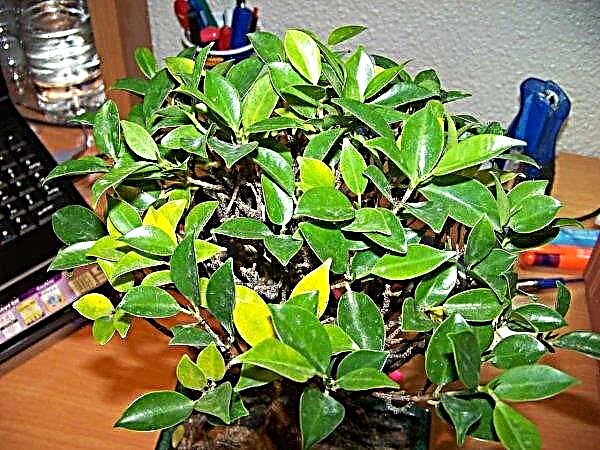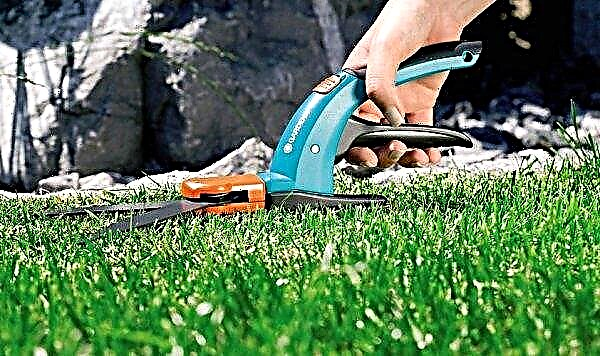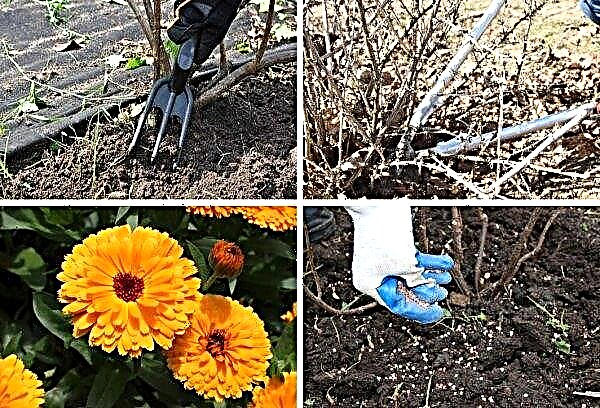The decorative bridge, which is placed near artificial ponds in the garden, is a unique design. It not only has an attractive appearance, but also gives the design of the site completeness. Therefore, when the owner of a summer residence decides to decorate his garden with such a product, he needs to thoroughly study their types and manufacturing methods.
Types of garden bridges in form and purpose
Before you start sketching, you need to consider the maximum number of bridge shapes. This will greatly facilitate the procedure for selecting the appropriate option for a particular site. This can be done both in the office of a landscape designer, or independently, using the Internet or specialized literature.
Did you know? In India, bridges have long been used, the foundations of which have grown in a natural way. Usually these are trees that themselves connect the two banks of the reservoir.
Experienced craftsmen recommend initially taking a picture of the place where the structure will be mounted. Then the photos are printed in large format. Templates made of paper are laid on it and they look which one will harmoniously fit into the surrounding landscape.
All garden bridges can be divided into several varieties:
- Straight. A man’s hand can create it without much effort. They fit almost any style and perform more decorative function than a platform for constant walking.

- Suspension. This is one of the most complex, but also beautiful forms of bridges. An important step in creating the design is to comply with safety rules, since an incorrectly selected mounting angle can unbalance it. Most often, they are placed over large and medium-sized ponds or rivers, if they flow along the site.

- Zigzag. It is believed that such designs are able to protect the owner from evil spirits. This superstition came to us from Asia, as did the very form of the bridge. In modern landscape design, they look original and unusual.

- Stepped. In most cases, these are two stairs from different sides. Between them, depending on the size, a large or small platform will be installed.

- Arched. This is a very common, bent up form of bridges. They can decorate almost any area. In landscape design they are used in any style.

- Step by step. This structure, consisting of individual elements - for example, large flat stones - is ideal for installation over small streams or artificial ponds. It can also connect the shores of a dry riverbed, playing rather a decorative role than a functional one.

The purpose of each of the above structures is the same: a bridge is the safest way to overcome a water barrier. In landscape design, he also plays the role of a design element. On this product you can walk in your free time, enjoying the fresh air and beautiful views.
Layout and design of the bridge
Any construction project cannot be presented without technical documentation. In most cases, these are detailed drawings and sketches. With their help, you can think over the smallest details of the future design on paper. The main thing is to clearly choose the dimensions and strictly follow them during the preparation of materials for construction. If there are no skills in drawing up drawings, then such work is trusted to professionals.
Important! Before designing, for example, a Japanese-style bridge, you need to familiarize yourself with the intricacies of this country's culture. If there are no other references to this style on the site, the design will lose its meaning and will not be in harmony with the surrounding landscape.
It will not be difficult for specialists in landscape design to create a sketch and submit it to the client for consideration. In addition, the time spent on the layout of the bridge will be significantly reduced. There are a lot of varieties of design of garden bridges, because each owner of a personal or country plot seeks to create something unique on it that the neighbors do not have. Therefore, during the preparation of drawings and sketches, the best adviser is his own imagination.
If the bridge should play not only a decorative, but also a functional role, you need to think about options that will be reliable. With self-assembly and assembly, it is better to choose designs that have proven themselves well before. Corresponding drawings and calculations of materials can be found on the Internet or in specialized literature.
Site selection and preparation
Like other elements of the arrangement of the site, the bridge should fit into the environment. So, if the territory has a large number of trees, then you can create a wooden bridge. And if the selected area is surrounded by water, you can mount a gazebo at the end of the bridge. It will be a beautiful and secluded place to relax with your family or friends.
The garden bridge should be installed in clearly defined places, namely:
- over natural barriers: a stream, a ravine, a small river or lake, a pond, a dried channel of a water artery;
- on flat areas where they will look like a continuation of the created garden paths (for example, the bridge over the flowerbed looks original, where it will become a specific viewing platform);
- over large water arteries, where it will play the role, for example, of the connecting element of the islets;
- over rock gardens, flower beds and other artificial elements of landscape design, where there is no water.
If the territory of the personal plot is small, then you should think about installing a small bridge. In landscape design, such structures are most often used for decorative purposes. Most often they are installed where it is necessary to emphasize the importance of any element of the decor. Often you can find original designs that connect the opposite sides of garden paths. Here they play the role of a means to overcome, for example, a small hill or hole in the ground. Be that as it may, before developing the design and drawings, you must first determine the location of the future design. When the dimensions of the bridge are known, it is only necessary to clean the sites from debris and strengthen the ground under the supports and foundation.
Here they play the role of a means to overcome, for example, a small hill or hole in the ground. Be that as it may, before developing the design and drawings, you must first determine the location of the future design. When the dimensions of the bridge are known, it is only necessary to clean the sites from debris and strengthen the ground under the supports and foundation.
DIY garden bridge making
Now, not only having the finished drawing in hand, but also having prepared the site for the construction of the bridge, we can safely consider options that are suitable in appearance to the surrounding territory.
Most often, a garden bridge is created from:
- a tree;
- metal;
- concrete or reinforced concrete.
Less often you can find designs made of natural stone.
Wood
Less expensive financially consider a wooden bridge. It can be easily built and installed. Individual parts can be fastened with nails or screws.
Before starting work, the master must prepare or purchase the following material and tools:
- Wooden stakes or bars for piles. They are used to create the foundation of the future design.
- A partition that is made of waterproof material. Its main task will be to prevent moisture and water from getting onto the bridge itself.
- Wooden poles. It will take 2 pcs. with a section of 75 × 75 mm. They are used to create the railing.
- Trims for the railing.
- Wooden planks to create a bridge span. Usually their length is 2 m, and the thickness is not less than 50 mm.
- Trims for installing transverse span mounts. Their thickness should be at least 40 mm.
- Body bolts. Used as fasteners for the span.
- Nails, bolts and ropes.
- Boards for flooring. Their thickness should be from 20 to 30 mm.
- Corrugated boards. They will be decorated flooring.
- Stones, gravel and pebbles. They are used for mounting the base of the bridge.
- Pliers, screwdriver, hacksaw, ax, vise and jigsaw. This tool will be needed to process wood and fasten bolts. You can use a power tool.
- Sandpaper, paint, varnish, antiseptic.
To ensure the integrity of the tree structure for a long time, before starting installation work it must be treated with an antiseptic and painted.
Progress:
- Before starting the assembly, you should start making the base. On it, the structure will be installed and fixed. To do this, create holes in the ground. Piles or stakes will be placed in them; in order to fix them in one place and not allow them to move, the recesses are filled with concrete.
- After this, you can begin to place waterproof material on both sides of the pond between the piles. They also place two long 2-meter boards for the span frame.
- If the bridge will have a convex shape, then the bars bend at the right angle. To facilitate this process, the tree is soaked for some time in water. It will gain the necessary flexibility and be able to bend in the right shape.
- Before fixing the bars on piles, it is necessary to cut off the edges - this will provide the most even joint. Before starting further work, wait until the wood dries.
- Using the screws, they connect the strips that were prepared to connect the span boards.
- At the same time, the flooring and railings are mounted. Between themselves, the individual parts are connected with nails. To prevent sliding on the structure while moving along it, install corrugated boards.
- To hide the waterproof film, pebbles or gravel are poured into the base of the structure, stones are installed.
 Such a beautiful bridge can be ennobled, giving uniqueness to the appearance in two ways: by coating with a layer of varnish or paint, or by creating a manual thread. As additional decorative elements, you can hang flowerpots with small but bright colors, on both sides of the railing. At the beginning and end it is possible to install small garden figures.
Such a beautiful bridge can be ennobled, giving uniqueness to the appearance in two ways: by coating with a layer of varnish or paint, or by creating a manual thread. As additional decorative elements, you can hang flowerpots with small but bright colors, on both sides of the railing. At the beginning and end it is possible to install small garden figures.
Metal
The main feature of such a bridge is the elaborate and delicate forms. In addition, such designs are distinguished by a rather long service life and increased reliability. Although most experts, due to the complexity of the forged elements, insist that it will not be possible to do the construction without assistance, you should consider the possibility of installing it yourself.
Did you know? In China, in the canyon of Zhangjiajie National Forest Park, a 430 m long bridge was constructed from glass panels enclosed in a metal frame. If you set yourself this goal, you can build a miniature copy of it in your summer cottage.
In order to complete the creation work, it is necessary to stock up on suitable tools and materials in advance:
- Any forged element can be purchased separately and connected using a welding machine.
- Sheets of iron and pipes are also easily purchased in specialized stores or at construction sites.
- If there is no special equipment, then you must seek help from a plumber. He must have a pipe bender.
- You will need a grinder, sandpaper, paint, files, solvent.
When assembling the finished structure, it is necessary to constantly bend metal and pipes, which will act as a railing. To do this, you must clearly follow the dimensions indicated in the drawings. In working with metal, a pipe bender, a set of various files, a grinder and a welding machine should be used. Forged elements prepared in advance are connected to the railing by welding. Overlays for the railing can be made of sheet steel - it bends easily, and you can create beautiful products right at the assembly site of the bridge. Pipes can also be used for the frame, and ordinary walls can be used as partitions. After finishing work, clean the metal from rust.. To do this, use sandpaper. Then the stripping points are treated with a solvent and painted in a suitable color.
Overlays for the railing can be made of sheet steel - it bends easily, and you can create beautiful products right at the assembly site of the bridge. Pipes can also be used for the frame, and ordinary walls can be used as partitions. After finishing work, clean the metal from rust.. To do this, use sandpaper. Then the stripping points are treated with a solvent and painted in a suitable color.
It is better to choose a waterproof paint that does not fade when exposed to sunlight and will not crumble in the cold. You can decorate a metal bridge with a variety of decorative elements - flowers in flowerpots, statues and figurines, decorative garden figures, lanterns, climbing plants, etc. If the volume of the reservoir is extensive, then fishing is also possible. Such a bridge can be decorated with various appropriate accessories.
Concrete
Such an original bridge will take a lot of effort, time and money, but it will be distinguished by reliability and durability. In addition, you can decorate a concrete bridge not only with flowers with flowerpots, but also with heavy marble statues and columns. On its sides you can place small lights that will illuminate the path in the dark. Various figurines, for example, garden gnomes, will be appropriate. They can be installed not only nearby, but also on the structure itself.
To successfully complete the work, it is necessary to collect and prepare materials and tools:
- shovel, concrete mixer, pliers, hammer, grinder;
- cement, sand and crushed stone for mortar;
- metal fittings and boards under the frame;
- paving stones or natural stone for decoration.
On both sides of the pond or paths create the foundation - the whole structure will be installed on them. They must be strong enough to support significant weight. A layer of waterproofing should be placed on top of them. Now they begin to build the bridge itself. The frame must be cast from concrete using metal binder reinforcement. To do this, you need a form that is mounted from boards and beams.
Important! Must choose the highest quality cement. It resists not only frost, but also destructive sunlight, preventing cracking of the surface.
The first layer of solution is poured into it. The rods are placed in it. A little more cement mortar is added on top to hide the surface of the metal reinforcement. After that, the base of the bridge should freeze. The layer width should be at least 10 cm. After 2-3 days, the concrete will completely harden.. Next, you need to remove the wooden bars that play the role of form, and the finished platform is installed on a previously prepared basis. After that, it remains only to decorate the walkways with the help of various elements. In this case, natural stone is used. From it create a low railing, and also laid on the floor surface - a rough surface will prevent slipping in winter. For beauty, it can be laid out in the form of a mosaic. If you create a garden path from the same material, for example, colored pavers, it will become a continuation of the bridge.
After that, it remains only to decorate the walkways with the help of various elements. In this case, natural stone is used. From it create a low railing, and also laid on the floor surface - a rough surface will prevent slipping in winter. For beauty, it can be laid out in the form of a mosaic. If you create a garden path from the same material, for example, colored pavers, it will become a continuation of the bridge.
Mounting and installation of a decorative bridge
Based on the above methods of assembling structures from any material, it is necessary to create a support on different banks of the reservoir. To do this, dig a hole in the ground, install concrete or wooden piles, fill it with cement mortar with crushed stone. The finished design is easy to install on these supports. It can be fixed using various fasteners - steel bolts, screws (if the bridge is not too heavy), creating a monolithic layer of concrete (in case of installation of reinforced concrete products).
It is recommended to find a helper, as the iron structure may be too heavy for one person. Together, it is evenly installed in the selected place. DFor a wooden and metal bridge, the supports must be wrapped with waterproofing. This material will help prevent rust and decay - such processes invariably pursue these two materials in close proximity to water. All of the above methods for manufacturing a decorative garden bridge can greatly simplify the work of a home master. However, it should be remembered that if you can not perform any part of the installation yourself, it is best to contact specialists. In addition, when hiring a landscape designer, a professional will engage in the selection of working personnel. Such a solution will cost more, but the design of the bridge will be aesthetic and reliable.
All of the above methods for manufacturing a decorative garden bridge can greatly simplify the work of a home master. However, it should be remembered that if you can not perform any part of the installation yourself, it is best to contact specialists. In addition, when hiring a landscape designer, a professional will engage in the selection of working personnel. Such a solution will cost more, but the design of the bridge will be aesthetic and reliable.


















